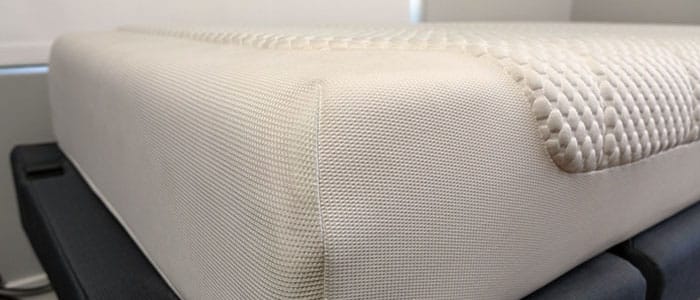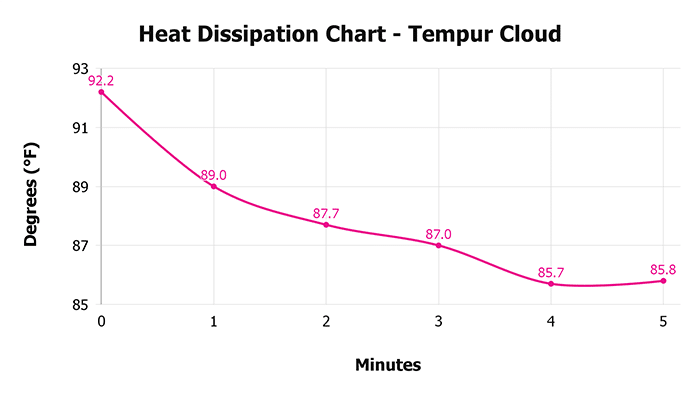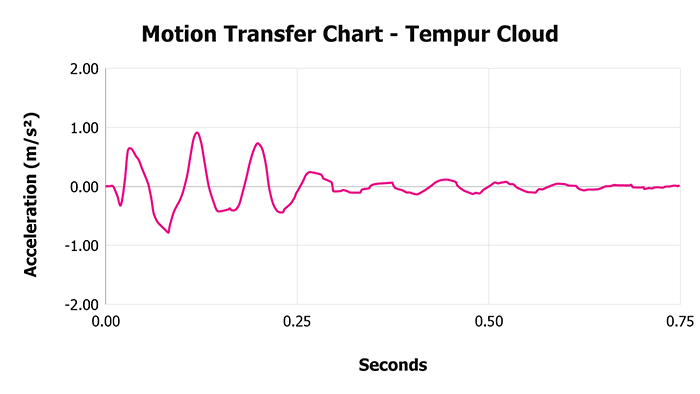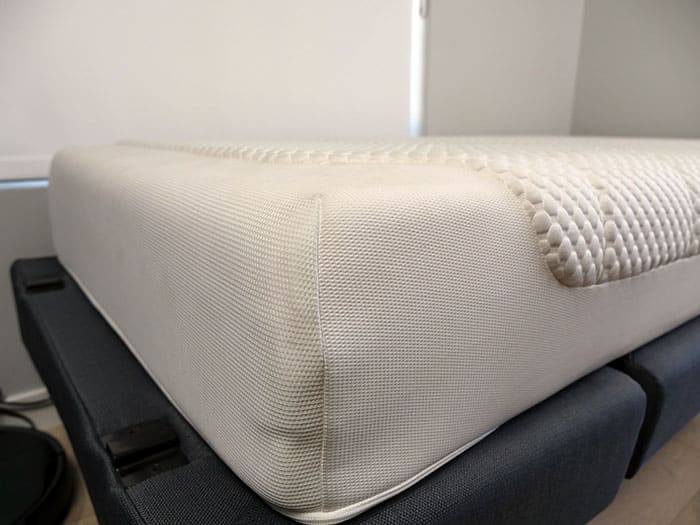Note: The Tempur Cloud is available both in the UK and the US, with slight variations between the two. This review is for the UK Tempur Cloud. For Tempurpedic in the US, click here.

Best For
- Extremely low motion transfer and moderate sinkage
- Quality material and brand history
- Different firmness levels and thickness levels available
Considerations
- Low levels of bounce
- Material retains more heat and may sleep warm
- Higher price point than comparable mattresses
Our Verdict
The Tempur Cloud is a UK-based mattress that uses a similar material as the Tempurpedic material in the US market. It is made from a blend of memory foam and support foam.
This mattress has deep sinkage and an extremely low level of bounce.
It is available in a single firmness, 5 out of 10, giving the mattress a medium feel. This makes the Cloud mattress a little softer than the Tempur Original.
In our performance tests, the Tempur Cloud had an overall score of 8.58, just slightly above the average performance level (8.57). Overall, the build quality and support of this mattress are nothing short of impressive.
This mattress is £1,319, the equivalent of $1748 for a queen-sized mattress. This is 53% more than the average memory foam mattress.
Type: Memory Foam
Firmness: Medium (5)
Best For: All Sleeping Positions, All Body Weights
In This Review
Performance Tests | Firmness | Support & Sleeping Positions | Design | Materials | Comparisons | FAQs
Across the pond, Tempur is a popular mattress option, not dissimilar from the US Tempurpedic, aside from naming conventions and some materials. It comes from a company with a long record of quality products and good customer service.
Let’s see how the Tempur mattress stacks up!
Performance Tests
At NapLab, we put each mattress to the test.
We test 10 different factors that impact the performance, comfort, and value of the mattress. We then take the results of that test and compare to every mattress we’ve tested to date.
Check out the full performance table below to see how this mattress ranks:
| Factor | Tempur Cloud | Average |
|---|---|---|
| Overall Score | 8.58 | 8.55 |
| Price (Queen) | £1,319 | $1,137 (Memory Foam only) |
| Cooling – Score | 8.0 | 8.8 |
| Sinkage – Depth | 2.36″ | 2.16″ |
| Sinkage – Feel | Deep | Moderate |
| Motion Transfer – Score | 10 | 8.2 |
| Motion Transfer – Acceleration | 1.68 m/s² | 8.64 m/s² |
| Response Time – Score | 7.5 | 8.9 |
| Response Time – Mostly Recovered | 0.6 sec. | 0.4 sec. |
| Response Time – Fully Recovered | 1.1 sec. | 0.9 sec. |
| Bounce – Height | 3.34″ | 9.53″ |
| Bounce – Feel | Extremely Low | Moderate |
| Edge Support – Score | 8.9 | 8.6 |
| Edge Support – Sitting | 4.00″ | 4.07″ |
| Edge Support – Lying | Excellent | Good |
| Sex – Score | 6.4 | 8.5 |
| Pressure Relief – Score | 9.0 | 8.8 |
| Comfort Layer Thickness | 7.0″ | 4.2″ |
| Mattress Thickness | 12″ | 12.0″ |
| Off-Gassing – Score | 10 | 8.4 |
| Off-Gassing – Smell | None | Strong |
| Off-Gassing – Days | 0 days | 6 days |
| Company – Score | 9.0 | 8.8 |
| Trial | 100 nights | 177 nights |
| Warranty | 10 years | 25% have lifetime warranties, average of other 75% of mattresses is 14 years |
How is Tempur Different?
The Tempur Cloud mattress has above-average overall performance and a price tag that is higher than average—15% higher than the average memory foam mattress (comparing UK and US models).
Advantages
Specific advantages for the Tempur mattress includes extremely low levels of motion transfer, slightly better edge support, and a thicker comfort layer.
Neutral Factors
Considering neutral factors, the Tempur Cloud has 8% deeper sinkage than average as well as 65% less bounce than average. Both bounce and sinkage are preferential factors and rely more on personal preference as to whether or not they are pros vs. cons.
Disadvantages
This mattress has a slower-than-average material response time, poorer cooling performance, and a shorter trial period (average is 177 nights).
Cooling Test
The Tempur Cloud has good cooling performance. During our tests, we did not note any significant heat issues.
Baseline Temp.
80.5° F
Max. Temp.
92.2° F
Ending Temp.
85.8° F
Max. Temp.

Ending Temp.

- Baseline Temperature – the temperature of the mattress before anyone lies on it
- Maximum Temperature (0 minute) – the temperature of the mattress after lying on it for 15 minutes
- Ending Temperature (5 minute) – the temperature of the mattress after being lied upon and having no one on it for 5 minutes
In our objective tests, we measured a max surface level temperature of 92.2° F. This is 2.6° more than the average of 89.6° F
After five minutes of being off of the mattress, the temperature decreased down to 85.8°, a decline of 6.4° F.
Heat Dissipation Over Time
The cooling of the Tempur mattress was more than a little surprising. The mattress is built from layers of memory foam, a material known to retain more heat. However, the surface of the mattress only hit a maximum of 92.2°. An impressive feat.

Sinkage Test
The Tempur Cloud has deep sinkage. During our tests, we measured a pressure point sinkage depth of 2.36″. This is 0.22″ more sinkage than the average sinkage depth of 2.14″, based on all of our tests to date.
Sinkage Depth
2.36″
Sinkage Feel
Deep
Body Contour
Dramatic
The mattress creates a deep hug and contour. While this is deeper than other mattresses we’ve tested, it’s pretty standard for a classic memory foam mattress.

Compared to other mattresses that we’ve tested, 2.36″ is considered to be deep sinkage. It’s enough to feel a strong level of pressure relief across your body, but not so deep as to create heating and ease of movement issues.
Motion Transfer Test
The Tempur Cloud has an extremely low level of motion transfer. During our tests, we measured a total acceleration range of 1.68 m/s². This is 81% less motion transfer than the average of 8.78 m/s².
Accel. Range
1.68 m/s²
Motion Duration
0.27 seconds
The level of motion transfer is documented in the video below.
After the initial bounce in our test, the ball does sink quite a bit into the mattress, but the energy of the ball moving back up is greatly declining.
In our motion transfer chart, which visualizes our accelerometer data, we can see the highest motion peaks from 0.08 to 0.10. By 0.27 seconds we’ve returned to near-zero levels of energy.
Motion Transfer Over Time

The Tempur foam does a great job of isolating the motion and absorbing energy.
In the real world, motion by a partner (at a decent distance away from the other partner), would rarely be so disruptive that you would wake or feel the movement.
Response Test
The Tempur Cloud has a moderate material response. In our mostly recovered test, we measured a recovery speed of 0.6 seconds, which is 0.20 seconds slower than the average of 0.40 seconds, based on all of our tests to date.
Mostly Recovered
0.6 sec.
Complete Recovery
1.1 sec.
The level of responsiveness is documented in the video below.
In our fully recovered responsiveness test, we measured a recovery speed of 1.1 seconds, which is 0.20 seconds slower than the average of 0.90 seconds.
Considering the classic properties of most memory foam, this is a faster response time than I expected to see.
Bounce Test
The Tempur Cloud has an extremely low level of bounce. During our tests, we measured a total bounce height of 3.34″. This is 6.19″ less bounce than the average of 9.53″, based on all of our tests to date.
Max. Depth
5.76″
Max. Rebound
-2.42″
Total Bounce
3.34″
With this Tempur Cloud mattress, the ball sank to a maximum depth of 5.76″ before rebounding upwards. Even though it did bounce up, it wasn’t enough for the ball to lift off of the surface of the mattress.
The level of bounce is documented in the video below.
Depending on personal preference, this could be a pro or a con. If you’re looking for maximum hug and contouring, this would likely be a good thing.
Ideally, I want to see 8-12″ of total bounce height. If you’re worried about being too sunk down into a mattress, you may want to opt for something with a little more bounce.
Edge Support Test
The Tempur Cloud has good edge support for sitting and excellent edge support for lying.
Max. Sinkage
4.00″
Lying Support
Excellent
Reinforced Edge
No
In our sitting edge support test, we measured a sitting sinkage compression of 4.00″. This is 0.04″ less sitting sinkage than the average of 4.04″, based on all of our tests to date.
The level of edge support while seated is documented in the images below.
Sitting, 140 lbs.

Sitting, 200 lbs.

While lying directly on the edge of the mattress I felt that the support was excellent in all sleeping positions.
The level of edge support while lying is documented in the images below.
Lying on Edge, 140 lbs.

Lying on Edge, 200 lbs.

Overall, I was happy with this performance for a memory foam mattress as oftentimes these softer foams may have really poor edge support. Without a coil base or reinforced edges, foam mattresses can be lacking. But that’s not the case with the Tempur UK.
Sex Test
The Tempur Cloud has mediocre sex performance. The biggest factors hurting the score here are low levels of bounce and good (but not great) edge support.
| Sex Factor | Factor Weight | Score | Rating |
|---|---|---|---|
| Bounce | 65% | 5.0 | Very Low |
| Edge Support | 20% | 8.8 | Good |
| Noise | 5% | 10 | Minimal |
| Pressure Relief | 5% | 9.0 | Excellent |
| Cooling | 5% | 8.0 | Good |
Bounce is very low at 3.34″, which is 6.19″ less than average bounce height of 9.53″—a substantial hit to the sex score.
Noise is minimal and pressure relief is excellent. Cooling is good as well, although none of these three factors have any substantial impact on the sex score.

Pressure Relief Test
The Tempur Cloud has an excellent level of pressure relief. During our tests, I felt no significant level of pressure points anywhere on my body.
Comfort Layer
7.5 cm
Support Layer
13 cm
For pressure relief, the thickness of the comfort layer plays a big role in how pressure points are distributed. On Tempur, it’s only 7.5 cm, which is a little thinner than we’ve seen on comparable mattresses. But it’s still 37% of the overall thickness, which is a good ratio to see.
If you have a heavier body you may find the limited comfort layer thickness results in pressure points. This is especially true if you sleep on your side and/or if you weigh more than 250 lbs.
Off-Gassing Test
Off-gassing on the Tempur Cloud was zero when we originally tested this mattress. The mattress was shipped to us uncompressed, from the UK to the US.
Initial Smell Strength
None
Off-Gassing Period
0 Days
Typically, foam mattresses will off-gas more when they are brand new (especially if they are compressed in a box). However, since the mattress shipped across an ocean uncompressed it had ample time to off-gas and lose any strong odors.
This isn’t to say that the mattress won’t smell, however, we are basing our findings on the data that we actually experienced in our test. And in our tests, the Tempur Cloud had no significant smell or off-gassing.
Company
The Tempur UK comes with a 100-night trial period, 10-year warranty, and free shipping and returns. Note: This mattress on ships to the UK. For Tempurpedic in the US, you’ll need to shop from their US storefront here.
| Company Factor | Factor Weight | Score | Data |
|---|---|---|---|
| Returns | 40% | 10 | $0 |
| Trial Period | 30% | 8.0 | 100 nights |
| Warranty | 20% | 8.0 | 10 years |
| Shipping | 10% | 10 | $0 |
| Country of Origin | 0% | Denmark + USA |
The Tempur mattress is not a new face to the mattress lineup. It’s been around for almost 30 years and has a history of quality products, albeit significantly more expensive than newer online brands.

Delivery of the Tempur mattress is free as long as it’s going to mainland UK.
The trial period looks good at first glance, but there are a few concessions. For example, the trial only applies to your first online Tempur mattress purchase.
Returning customers or other purchases beyond the mattress would be subject to a minimal 14-day return window.
The 100-night trial is also excluded for any mattress marked as “Special Buy”, “Limited Stock”, “Exclusive” or other Clearance purchases.
Lastly, let’s talk about warranty. Tempur comes with a 15-year warranty, which breaks down as a 5-year full replacement, wherein the last 10 years are prorated.
How firm is Tempur UK?
The Tempur Cloud falls around a 5 out of 10 on the firmness scale. It’s a little firmer than other “soft” mattresses, but definitely softer than the Tempur Original.

Other Firmness Levels
Outside of the Tempur Cloud, there is are also firmer options.
If you’re looking for something just a touch firmer…
- Try the Tempur Hybrid which comes in around a 5.5 out of 10, using a blend of Tempur foam and pocketed coils.

If you’re looking for something even firmer…
- Try the Tempur Original which uses the original Tempur foam and a firmenss around 6 out of 10, with an all foam construction.

If you’re looking for something significantly firmer…
- Try the Tempur Sensation which has a firmness level around 8 out of 10, with an all foam construction.

Support & Sleeping Positions
Support on the Tempur Cloud is excellent. During our tests, I felt well-supported in all sleeping positions. The mattress is equipped with a 5.0″ support layer.
| Support Factor | Data |
|---|---|
| Comfort Layer | 7.0″ |
| Support Layer | 5.0″ |
| Firmness | Medium |
| Body Contour | Dramatic |
| Zoned Support | No |
| Reinforced Edge | No |
This is 2.88″ thinner than the average support layer thickness of 7.88″, based on all of our tests to date.
Equally importantly, the mattress also has a 7.0″ comfort layer. For a mattress to be supportive, it must be capable of creating sufficient comfort so sleepers can lie in the same position, while also achieving a neutral spinal alignment for sleepers.
The 12.0″ of total height on the Tempur Cloud is able to accomplish that.
Looking specifically at the Tempur Cloud, here is an idea of who it may be a good fit for.
| Sleeper Weight | Stomach Sleepers | Side Sleepers | Back Sleepers |
|---|---|---|---|
| Under 150 lbs. | Yes | Yes | Yes |
| 150-250 lbs. | Yes | Yes | Yes |
| 250-300 lbs. | Maybe | Yes | Maybe |
The mattress has a medium feel and a deep level of sinkage. This comfort dynamic is best suited to the needs of side sleepers and lighter-weighted back or stomach sleepers.
Based on all of my tests to date, an analysis of the materials, and my subjective experiences, I’m confident most sleepers will find support on the Tempur Cloud is excellent.
Design
The design of the Tempur Cloud feels similar to other Tempur mattresses. It uses an all-foam construction with the classic memory foam feel.
| Design Factor | Data |
|---|---|
| Type | Memory Foam |
| Thickness | 12.00″ |
| Cover Type | Thin |
| Weight | 57 lbs. |
| Has Handles | No |
| Fiberglass-Free | No |
| Ships in a Box | Yes |
This mattress is designed for deep compression, pressure relief, and high levels of contour and hug.
Here are some quick specs about the Tempur Cloud mattress:
Materials
The collection of Tempur mattresses may use slightly different materials, but the basic approach is quite similar. Proprietary Tempur material mimics the look and feel of classic memory foam. It’s soft, conforming, and tends to retain heat a little more than other foams.
Tempur combines layers of this material in variable thicknesses and densities to provide different feels for each different mattress they produce.
Because this mattress is specifically looking at the Tempur Cloud, that’s the main mattress that we’re going to focus on right now.
The five main layers of the Tempur Cloud include:
| Layer Type | Thickness | Layer Specs |
|---|---|---|
| Memory Foam | 1.0″ (2.5 cm) | Not Available |
| Memory Foam | 2.0″ (5 cm) | Not Available |
| Support Foam | 2.5″ (6.5 cm) | Not Available |
| Support Foam | 2.5″ (6.5 cm) | Not Available |

The Cover
The top cover of the Tempur mimics that of other Tempur mattresses. It has a plush quilted core and thin stretchy, water-resistant sides.
The raised portions of the cover do tend to show dirty and age quicker. To prevent this, consider adding a mattress protector to the top of the mattress.

The sides of the cover use a thinner material, which helps the mattress release heat while you sleep.
Regardless of which Tempur mattress you go with, each one has a removable machine-washable cover, which does make it easier to keep the bed clean.
The Comfort Layers
Right beneath the cover is a layer of 2.5 cm thick comfort memory foam. This is the softest foam and allows the most amount of sinkage.
Below the first layer of comfort foam is actually a second comfort layer, which is twice as thick, around 5 cm. This layer is a little denser than the top layer and provides more support.
The Support Layers
This includes two 6.5 cm corrugated support foams that provide deep support and also help to allow air to pass through between the foam layers.
Tempur Thickness Levels
There are three different thickness levels for the Tempur mattress.
- Supreme: 21 cm
- Elite: 25 cm
- Luxe: 30 cm

The thickness of each mattress is made up of a blend of comfort foam, support foam, and a high-density base. Here is a breakdown of how each version is slightly different.
Supreme
- 5cm Tempur material
- 5cm support foam
- 11cm DuraBase™ Technology
Elite
- 7cm Tempur material
- 7cm support foam
- 11cm DuraBase™ Technology
Luxe
- 7cm Tempur material
- 9cm support foam
- 6.5cm DuraBase™ Technology
- 7.5cm DuraBase™ Technology
Product Evolution
The evolution of the Tempur mattress is a constantly moving target. Tempur has undergone decades of changes in models, styles, and design.
One feature that remains consistent across most Tempur mattresses is the use of their proprietary Tempur foam.
This foam has a similar feel to classic memory foam and is known for its deep compression, contour, hug, pressure relief, and motion isolation.
Tempur Models
There are a number of different Tempur mattress varieties on the market. The five most popular and flagship models include:
| Model | Materials | Firmness |
|---|---|---|
| Cloud | Extra soft Tempur foam | Soft |
| Original | Original Tempur foam | Medium |
| Hybrid | Pocketed coils + Tempur foam | Medium |
| Sensation | High-density Tempur foam | Firm |
Which Tempur is Right for You?
Go with the Tempur Hybrid if you’re looking for:
- More bounce
- Better cooling
Select the Tempur Sensation if you’re looking for:
- A firmer feel
- A mattress for heavier or back sleepers
Try the Tempur Original if you’re looking for:
- True ‘medium’ firmness
- Classic Tempur feel
Do the Tempur Cloud if you’re looking for:
- A softer feel
- A mattress for petite or side sleepers
Frequently Asked Questions
You can use similar questions, as long as they are still relevant. But please include new ones and/or exclude existing ones where appropriate
The cost of a Tempur mattress varies depending on what size you’re looking for but in general, it’s going to be one of the most expensive mattresses on the market. For a double, prices range from £1,700 – £2600.
The purchase of any Tempur mattress comes with a 100-night trial period, a 10-year warranty, and free shipping within mainland UK. If you decide that the mattress isn’t right for you, they offer free returns for any reason within the trial period.
Yes. There any many in-store setups of Tempus mattresses. That being said, the Tempur material may respond differently in-store than in your home, so it is recommended to take advantage of the trial period and try the mattress for at least 30 nights before making a decision.
Cleaning a Tempur mattress is similar to how you would clean any other foam-based mattress. You can spot clean with cold water and mild detergent or vacuum the mattress. To avoid stains and spills altogether, consider adding a waterproof mattress pad or a 6-sided mattress encasement.


